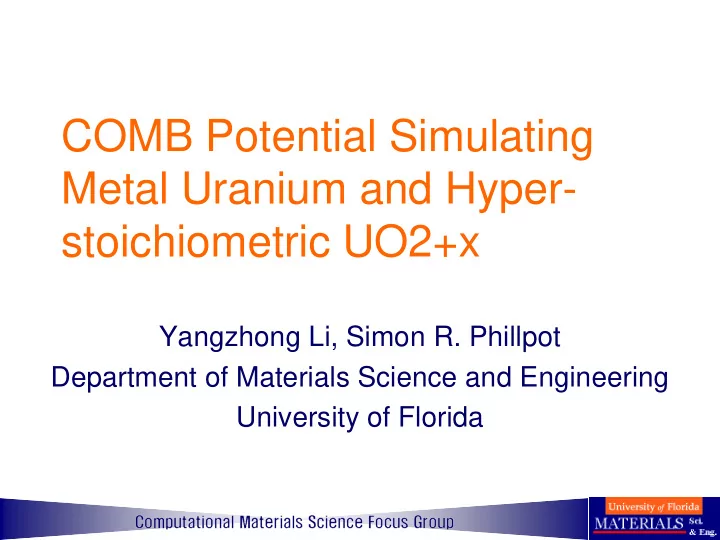

COMB Potential Simulating Metal Uranium and Hyper- stoichiometric UO2+x Yangzhong Li, Simon R. Phillpot Department of Materials Science and Engineering University of Florida
2 α -U lattice Structure of α -U Exp COMB DFT a ( Å) 2.85 2.78 2.74 b ( Å) 5.87 6.15 5.86 c ( Å) 4.96 4.80 4.96 α -U EC Exp COMB y 0.102 0.092 0.099 C 11 214.7 164.7 V ( Å 3 ) 82.99 80.95 79.64 46.5 C 12 94.0 C 13 21.8 61.3 bcc-U Exp DFT COMB 198.6 C 22 204.5 a 0 ( Å) 3.47 3.43 3.51 C 23 107.6 20.3 E – E( α ) 0.28 0.45 C 33 267.1 261.8 B (GPa) 113 136 135 124.5 135.1 C 44 73.4 C 55 62.7 74.3 C 66 54.5 B 113.1 109.0 84.34 G 73.6
3 MD Simulation – Lattice Parameter • COMB captures the anisotropic variation of unit cell lattice 6.5 α - β 6 Exp a 5.5 Lattice Parameter (Å) Exp b 5 Exp c Exp 3 √V 4.5 β - γ 4 MD a 3.5 MD b MD c 3 MD 3 √V 2.5 0 100 200 300 400 500 600 700 800 900 1000 1100 1200 Temperature (K)
4 UO2 Static Property (eV) DFT COMB Exp DFT COMB Exp OI -2.45 -1.16 a 0 ( Å) 5.41 5.47 5.47 OV 6.35 9.12 C11 387 386 389 UI 7.33 5.84 UV 3.84 15.72 C12 113 119 119 O FP 3.90 7.96 3-4.6 C44 71 60 60 U FP 11.17 21.56 8.5-9.6 B 204 211 209 Schottky 14.03 33.9 6-7 G 93 90 84 Uranium 2.5 0.9 Charge
5 UO2 MD Simulation • Structural stability COMB Exp • Solid: 0-3200K • O melting: 3200-4200K O melting 3200K 2670K • Lattice melting: >4200K Lattice 4200K 3100K melting 100 90 CTE × 10 6 10 10-30 80 Cp*10^5 (eV/K) 70 60 Δ H fusion 50 70 ± 4 51 (kJ/mol) 40 30 20 Δ V/V fusion 10 7.6% 8.0% 0 0 500 1000 1500 2000 2500 3000 3500 4000 4500 5000 5500 6000 T (K)
6 UO2+x Model • U sublattice remains in fcc structure • Original cubic O lattice rearrange to accommodate new O interstitial • Most O remains in cubic structure • Some O cube become cuboctahedron (COT) • Willis 2:2:2 model
7 Willis 2:2:2 Model • A model of conjecture based on diffraction data • 2 O vacancy; 2 O’ displaced by 1 Å; 2 O’’ displaced by 1 Å • Further developed to explain the U4O9 structure; the 2:2:2 chain • The 2:2:2 chain model contradict with later exp data • The Willis 2:2:2 model is proved unstable by DFT • The 2:2:2 chain structure in COMB changes from 10 coordinated to 8 for U
8 COT Structure • DFT shows a COT oxygen within a fcc U is a stable structure • COT with an extra O at the center is more stable than a one without • COMB shows that U4O9 becomes UO2+x at 1400K; matches exp result r U ( Å) r O ( Å) UOU ( deg ) OUO ( deg ) Method Structure U–O Exp 2.79 2.79 2.93 127.9 141.5 U4O9-o 2.76 2.76 2.90 127.9 141.6 DFT U4O9-v 2.92 2.92 2.82 139.7 129.8 U4O9-o 2.26 2.65 3.09 112.6 151.5 COMB U4O9-v 2.37 3.15 2.81 141.6 116.1
9 Center O in COT • A center O stabilize the COT structure (top row) • Otherwise COT collapses to form cube (down row) 0K 300K 600K 1000K 2000K
10 UO2.25 Structure • Pristine UO2 unit cell + one O at cubic center • O displaced from cubic center in 10ps • O forming fragments of COT • COT centers on U but not O atom! • COT-building process might never completed in COMB MD since it requires highly cooperating motion of O A small portion of UO2.25 showing the formation process of a COT structure at 40ps
11 Conclusion • COMB U potential is able to capture the order and sign of lattice variation at different direction • COMB UO2 potential is able to generate consistent results with DFT and experiment • UO2 lattice, elastic, defect, dynamic and fusion parameters are of good quality DFT & Exp COMB Willis 2:2:2 unit 2:2:2 unit not stable 2:2:2 unit & chain disassemble and chain 2:2:2 chain is wrong COT, U4O9 O-centerd COT matches U4O9 with O center in MD is exp result better more stable than without UO2.25 Becomes U4O9 at this O/U Form COT fragment, but ratio centered by U
Recommend
More recommend